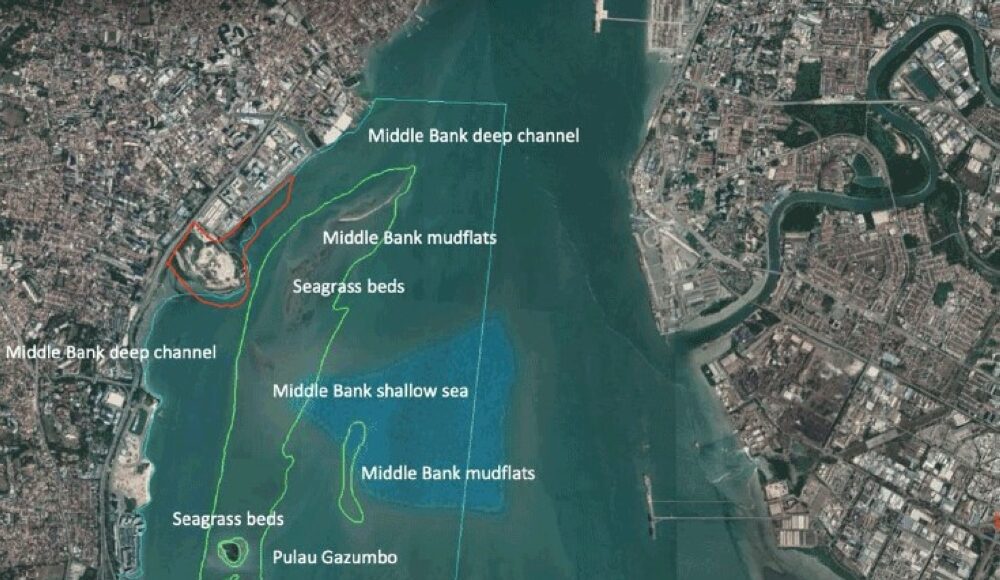MARCH 30 — The Protect Karpal Singh Drive Action Committee (ProtectKarpal), representing residents from multiple residential communities in the affected area, stand united in our deep concern over the proposed land reclamation project off Karpal Singh Drive, which threatens the ecologically vital Middle Bank Marine Sanctuary. Despite assurances from Chief Minister Chow Kon Yeow that the project will not encroach on the sanctuary, scientific evidence and expert analysis strongly suggest otherwise.
The Penang Institute, the state’s own think tank, has published a report (Protecting Penang’s Marine Biodiversity: Establishing the Middle Bank Marine Sanctuary) emphasising the sanctuary’s ecological significance and the urgent need for its protection — yet the Chief Minister’s stance contradicts its own findings.
The middle bank: A sanctuary of global importance
According to the report, the Middle Bank Marine Sanctuary spans 10 square kilometres in the Strait of Penang and is home to 429 species, including:
- 7 species of seagrass, vital for carbon storage and marine life habitats
- 139 commercial fish species, sustaining local fisheries and livelihoods
- 102 bird species, including migratory species like the endangered Far Eastern Curlew
- 7 marine mammals, such as dolphins, whales
- 2 species of turtles
- 100 mollusc species and 23 arthropods, including critically endangered horseshoe crabs
This sanctuary is a natural defense system for Penang. Its ecosystems — seagrass beds, mudflats, and mangroves — provide coastal protection, stabilise the seabed, and mitigate climate change by sequestering carbon up to 40 times more effectively than forests. It supports artisanal fisheries, purifies water, and shields our shores from erosion and tsunamis, as demonstrated during the 2004 disaster.
The threat: Reclamation’s hidden dangers
The proposed project involves reclaiming 70 acres of sea using 5.2 million cubic meters of sand, perilously close to, and encroach to, the sanctuary’s boundaries. In fact, the developer’s own EIA report admitted that “The project site including the proposed reclamation area is located at the middle banks…” (Page 6.35). The reclamation site lies within or adjacent to the Middle Bank’s deep channel, as defined by the Penang Institute’s research.
Assuming that the Chief Minister claims of no physical encroachment is true, he also overlooks the indirect, yet devastating impacts reclamation will have on the ecosystem. Even without direct overlap, the cascade of indirect impacts — sedimentation, habitat destruction, and disrupted currents — will devastate this fragile ecosystem.
The red outline was added to approximate the extent of the reclamation site. — Picture courtesy of Penang Institute
Leading marine scientists have raised critical concerns
Professor Aileen Tan, Director of Universiti Sains Malaysia’s Centre for Marine and Coastal Studies, warns that the project’s 500-metre buffer zone will encroach into half of the Middle Bank, risking irreparable harm to the seagrass meadows.
Dr. Jilliana Ooi, a marine ecologist from Universiti Malaya, explains that reclamation alters hydrodynamics, causing siltation and sedimentation that can smother seagrass beds (hydrodynamics). She notes restoration efforts have a success rate of less than 40 per cent, rendering replanting largely ineffective.
These indirect effects — sedimentation, pollution, and altered water flow — will extend beyond the project’s physical boundaries, suffocating the sanctuary’s ecosystems and collapsing its biodiversity.
Science over assurances
Evidently, the Chief Minister’s assertion that the project poses no threat to the sanctuary is not supported by scientific evidence. The sanctuary’s role as a global asset was underscored in 2022 with the discovery of two new sea cucumber species, Euthyonidiella zulfigaris and Acaudina spinifera. Destroying it would erase a scientific and ecological legacy.
Our call to action
We, the residents of Karpal Singh Drive, urge the state government to:
- Gazette the Middle Bank Marine Sanctuary: Prevent the unnecessary destruction of vital marine life and coastal habitats that are crucial for our ecological balance and future generations.
- Halt the reclamation project until a comprehensive, independent environmental impact assessment is conducted, accounting for both direct and indirect effects.
- Extending the Jelutong Landfill rehabilitation timelines to 5 to 10 years would allow in-situ rehabilitation, eliminating the need for 70 acres of reclamation.
- Engage scientists, conservationists, and local communities to find a balanced solution that protects Penang’s marine heritage while addressing development needs.
This is not a choice between progress and preservation — urban development and conservation can coexist. The Middle Bank sustains our fisheries, shields our shores, and fights climate change. We cannot afford to lose it.
* The Protect Karpal Singh Drive Action Committee represents residents from multiple residential communities in the affected area. The committee was formed to advocate for a sustainable and environmentally responsible approach to the landfill’s rehabilitation and to oppose the proposed 70-acre coastal reclamation project.
** This is the personal opinion of the writers or publications and does not necessarily represent the views of Malay Mail.





